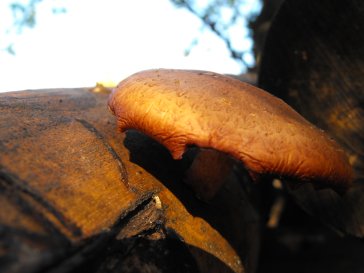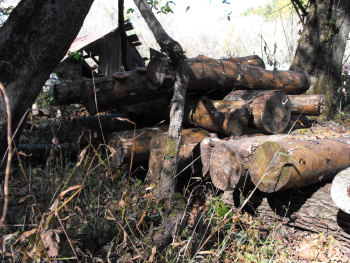
20081023shitakes
Mark says:
We were invited last year to split a large order of shitake mushroom
plugs by some friends and it turned out to be a very productive
project. You need to cut some hard wood logs into 3 or 4 feet sections
and then drill about 50 holes in each log. The next step is to hammer
each shitake plug into one of the holes, pushing it in just below the
surface of the wood. Then you pour some hot wax over the hole to seal
it up and wait 6 to 9 months. We use a small kiddie swimming pool to
soak the logs in water which stimulates fruiting. Our total number of
plugs was around 500, which was a nice amount, but since they taste so
good as a pizza topping I think we might double that when we get ready
for the next round of plugging.

According to the Shitake
Center some researchers have reported that a daily diet of 9 grams
or 10 medium sized mushrooms can lower blood cholesterol levels as much
as 45 percent. A highly purified polysaccharide fraction is being
extracted from shitake mushrooms in Japan and being used in
conventional cancer therapy. Mushroom extracts have become the leading
prescription treatment for cancer in Japan and parts of China.
Lentinan is what the shitake extract is called and it is generally
administered by injection and has been used as an agent to prolong
survival of patients in conventional cancer therapy.
Shitake mushrooms are listed as having antifungal, anti-tumor, and
antiviral effects (The
Biology and Cultivation of Edible Mushrooms) and are
known to contain all eight essential amino acids in better proportions
than soy beans, milk, or even eggs. Top that off with a good blend of
vitamins A, B, B12, C, D, and Niacin and you have one heck of a food
staple that's easy to cultivate and delicious to consume.
Anna adds:
We have
fourteen logs which is just about the right number to feed us mushrooms
1-2 dinners per week during the growing season. Every week, I
soak three logs using a friend's tap and submerge technique.
First, I lift the log up about a food above a cinderblock and drop it
end first so that it taps and supposedly activates the mushrooms.
No clue if that works, but it certainly doesn't hurt. Then I put
the log (along with two other tapped logs) in a kiddie pool which stays
full of water and put cinderblocks on each end of the logs to keep them
submerged. Twenty-four hours later, I remove the logs, and in
another week or so they start to fruit.
 At first, I had some trouble figuring out which logs had been most
recently soaked --- it's important to give them a month's rest between
soakings. I labelled the ends of the logs with an indelible
marker, and soon couldn't read my numbers... So I started simply
having two piles each stacked with three logs per row --- now I
take the top three logs from the unsoaked pile, and after I soak them
put them on the top of the soaked pile. Once the unsoaked pile is
completely gone, I rotate the soaked pile top to bottom and begin
again, keeping my logs in order.
At first, I had some trouble figuring out which logs had been most
recently soaked --- it's important to give them a month's rest between
soakings. I labelled the ends of the logs with an indelible
marker, and soon couldn't read my numbers... So I started simply
having two piles each stacked with three logs per row --- now I
take the top three logs from the unsoaked pile, and after I soak them
put them on the top of the soaked pile. Once the unsoaked pile is
completely gone, I rotate the soaked pile top to bottom and begin
again, keeping my logs in order.
Most books recommend using oak for your logs, but you can actually use
several different hardwood species. I read that sycamore is
widely used in nearby North Carolina, so that's what we've used and it
worked well. Our friends used Sugar Maples, which also worked
well. Shitake
Mushrooms Production and Marketing (an extention service document)
gives a list of some acceptable tree species to use with shitakes,
though I notice it doesn't mention sycamore which does work.
Want more in-depth information? Browse through our books.
Or explore more posts by date or by subject.
About us: Anna Hess and Mark Hamilton spent over a decade living self-sufficiently in the mountains of Virginia before moving north to start over from scratch in the foothills of Ohio. They've experimented with permaculture, no-till gardening, trailersteading, home-based microbusinesses and much more, writing about their adventures in both blogs and books.
Want to be notified when new comments are posted on this page? Click on the RSS button after you add a comment to subscribe to the comment feed, or simply check the box beside "email replies to me" while writing your comment.
